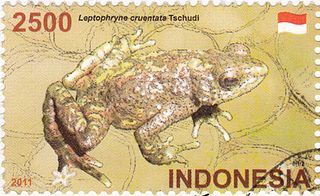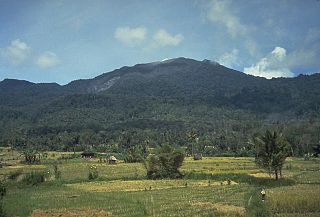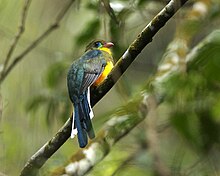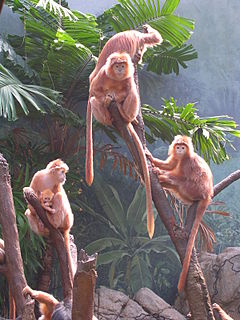
Meru Betiri National Park is a national park in the province of East Java, Indonesia, extending over an area of 580 km2 of which a small part is marine (8.45 km2). The beaches of the park provide nesting grounds for endangered turtle species such as leatherback turtles, hawksbill turtles, green turtles, and olive ridley turtles.

Baluran National Park is located in Situbondo Regency, East Java, Indonesia. It has a relatively dry climate and mainly consists of savanna (40%), as well as lowland forests, mangrove forests and hills, with Mount Baluran (1,247m) as its highest peak.

Ujung Kulon National Park is at the westernmost tip of Java, in Banten province of Indonesia. It includes the volcanic island group of Krakatoa in Lampung province, and other islands including Panaitan, as well as smaller offshore islets such as Handeuleum and Peucang in the Sunda Strait.

The bleeding toad, fire toad, or Indonesia tree toad is a species of true toad endemic to Java, Indonesia. It is listed as a critically endangered species due to a drastic population decline, caused in part by habitat loss due to global climate change and the eruption of Mount Galunggung in 1987. Chytridiomycosis has been identified as a possible threat, but no positive identification has been made. It is possible that the chemical cocktail secreted by the toads provides them with some resistance to the fungus.

West Bali National Park is a national park located in Buleleng Regency, Bali, Indonesia. The park covers around 190 square kilometres (73 sq mi), of which are 158 square kilometres (61 sq mi) land and the remainder is sea. This is approximately 3% of Bali's total land area. To the north, it includes a 1,000-metre (3,300 ft) long beach, reef and islets. A seaport at Gilimanuk is west of the park, and the village of Goris is to the east. The National Park can be reached by roads from Gilimanuk and Singaraja, or by using ferries from Ketapang, East Java.

Bromo Tengger Semeru National Park or local people known as TNBTS is a national park located in East Java, Indonesia, to the east of Malang, to the south of Pasuruan and Probolinggo, and to the southeast of Surabaya, the capital of East Java. It is the only conservation area in Indonesia that has a sand sea, the Tengger Sand Sea, across which is the caldera of an ancient volcano (Tengger) from which four new volcanic cones have emerged. This unique feature covers a total area of 5,250 hectares at an altitude of about 2,100 metres (6,900 ft). The massif also contains the highest mountain in Java, Mount Semeru, four lakes and 50 rivers. It is named after the Tengger Kingdom.

Sody's tree rat is a rodent species in the family Muridae that has been recorded only in bamboo forest in Gunung Gede Pangrango National Park, West Java, Indonesia. It was first recorded during surveys carried out between 1933 and 1935 at an altitude of 1,000 m (3,300 ft). It is dark brown and has yellow to ochre spots. Its tail is uniform brown. Its head-to-body length ranges from 190 to 210 cm with a 270 to 305 cm long tail. Its long feet indicate that it is adapted to living in trees.

Bartels's rat is a species of rodent in the family Muridae. It is found only in West Java, Indonesia, including in Gunung Gede Pangrango National Park.

The Bantam caecilian is a species of amphibian in the family Ichthyophiidae of caecilians, endemic to Indonesia. Until its rediscovery in 2000, it was known only from the 1827 type specimen.

The Javan torrent frog is a species of frog in the family Ranidae. It is endemic to Java, Indonesia. It is found in Mount Halimun Salak National Park, Ujung Kulon National Park, and Gunung Gede Pangrango National Park in West Java, as well as in Dieng Nature Reserve in Central Java.

The Javan ferret-badger is a mustelid endemic to Java and Bali, Indonesia. It is listed as Least Concern on the IUCN Red List and occurs from at least 260 to 2,230 m elevation in or close to forested areas.

Mount Ciremai National Park is located around 50 km to the south of the city of Cirebon in West Java, Indonesia. The park extends into the Kuningan and Majalengka regencies south of Cirebon. The park surrounds Mt Ceremai, an active volcano, the highest peak in West Java. Groups of hikers, including parties of students, often climb the peak although care is needed.

Mount Pangrango is a dormant stratovolcano located in the Sunda Arc of West Java, Indonesia. The mountain formed by a subduction zone on the southern coast of Java facing the Indian Ocean. It is located about 80 km south of Jakarta, capital of Indonesia.

Mount Halimun Salak National Park is a 400 km2 conservation area in the Indonesian province of West Java on the island of Java. Established in 1992, the park comprises two mountains, Mount Salak and Mount Halimun with an 11-kilometer forest corridor. It is located near the better known Mount Gede Pangrango National Park, but the national park should be accessed from Sukabumi, 2 hours drive to the administration post and then 2 hours drive again to Cikaniki post gate.

The Javan leopard is a leopard subspecies confined to the Indonesian island of Java. It has been listed as Critically Endangered on the IUCN Red List since 2008. The population is estimated at less than 250 mature individuals, with a decreasing population trend. The total remaining habitat is estimated at only 2,267.9 to 3,277.3 km2.
Cibodas Botanical Gardens is a 84.99 hectares botanical garden on the slopes of Mount Gede, located in the Cibodas subdistrict of West Java, Indonesia. It is operated by the Indonesian Institute of Sciences (LIPI).

Batang Gadis is a national park covering 1,080 km2 in North Sumatra province, Indonesia extending between 300 and 2,145 metres altitude. It is named after the Batang Gadis river that flows thorough the park. Signs of the endangered Sumatran tiger and the threatened Asian golden cat, leopard cat and clouded leopard were seen in the park. The protection of Batang Gadis as a national park is part of a plan to create the Northern Sumatra biodiversity conservation corridor, which would be connected, via a series of protected areas and forests, to Gunung Leuser National Park in the north of the island.




























